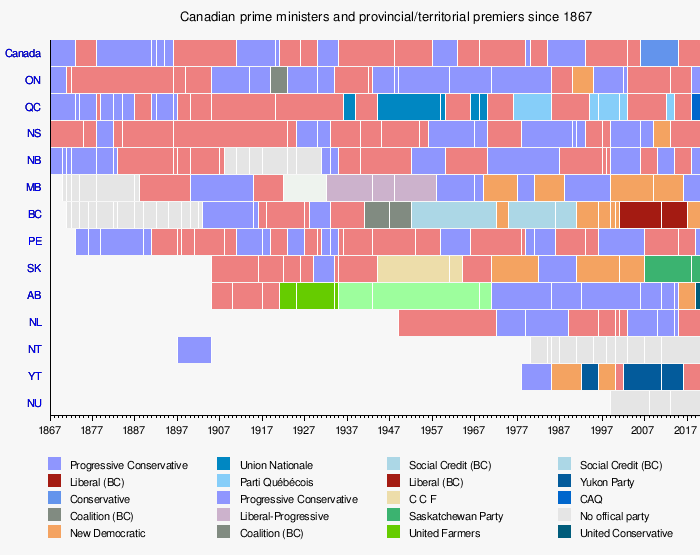Premier (Canada)
In Canada, a premier is the head of government of a province or territory. Though the word is merely a synonym for prime minister, it is employed for provincial prime ministers to differentiate them from the Prime Minister of Canada. There are currently ten provincial premiers and three territorial premiers. These persons are styled The Honourable only while in office,[1] unless they are admitted to the Queen's Privy Council for Canada, in which case they retain the title even after leaving the premiership.
The prime minister – premier distinction does not exist in French, with both federal and provincial first ministers being styled premier or première ministre.
Name
In a number of provinces, premiers were previously known by the title prime minister, with premier being an informal term used to apply to all prime ministers, even the Prime Minister of Canada. This practice was eventually phased out to avoid confusing the provincial leaders with the federal prime minister, as well as to indicate the distinct nature of the provincial offices. Officially, the last such case outside Quebec was that of W. A. C. Bennett, who served as Premier of British Columbia and styled himself as prime minister until leaving office in 1972. The title premier is not granted by any written law. The formal name of the government position held by the premier is President of the Executive Council or some similar term, but that formal term is rarely used.
In Canadian French, the head of government of a province or territory is called premier ministre: the French language does not have a synonym for prime minister. In Quebec, this designation is often translated to prime minister in English. The designation, however, is not exclusive. When they visit Quebec or are described by the Quebec government or many Quebec media, all the other heads of government of the other provinces are also called prime minister in the English version of the official French texts. The name of the province is always added to avoid confusion.
The terms prime minister and premier come from the United Kingdom, where there is only one prime minister/premier. Prime ministers of constituent countries in the UK are titled first minister. Collectively, Canada's federal prime minister and the premiers are collectively referred to as first ministers, another synonym of British origin.
Role
Under Canada's system of responsible government, the premier is both a member of the provincial legislative assembly and the head of the executive. The premier normally holds a seat in the legislative assembly, being elected in one of the electoral constituencies of the province. The leader of the party which commands a majority in the assembly is then legally appointed the premier by the lieutenant governor, representing the Canadian monarch in right of the province. While most often the leader of the largest party in the provincial legislature is invited to become premier, this is not always the case, the most recent occurring after the 2018 general election in New Brunswick.
Premiers advise the lieutenant governor on whom to appoint to the cabinet and they guide legislation through the legislature. Premiers thus exercise a significant amount of power within the Canadian federation, especially in regard to the federal government. In many ways they remain the most effective representatives of provincial interests to the federal government, as parliament's strong party discipline and other factors have impaired provincial representation there. This reality is acknowledged in annual "first ministers conferences" in which the federal prime minister and the 10 premiers meet to discuss provincial-federal relations. The Meech Lake Accord proposed that these meetings be constitutionally mandated, and some premiers have even proposed that these meetings become a formal branch of government, active in the legislative process (see Council of the Federation). However, only one Canadian provincial premier has ever gone on to serve as prime minister: Sir John Thompson. Canada's first and sixth prime ministers (Sir John A. Macdonald and Sir Charles Tupper) had also been co-premier and premier of British provinces that became part of Canada, but no one who has led a victorious general election campaign in a Canadian province has ever been prime minister.
Canada's three territories have premiers as well, though they are technically known as "government leaders". The Premier of Yukon is chosen in the usual fashion, but the premiers of Nunavut and Northwest Territories are selected from within the small and non-partisan elected territorial councils.
Current premiers
Timeline
 |
See also
- Premiers of the Australian states
- Governor (United States) (the head of government in the states of the United States)
References
- Styles of address
- "Honourable Stephen McNeil". Government of Nova Scotia. Retrieved October 22, 2013.
- "Office of the Premier". Government of Newfoundland and Labrador. Retrieved January 25, 2014.
- "Office of the Premier". Government of Manitoba. Retrieved May 12, 2016.
- "Office of the Premier". Government of British Columbia. Archived from the original on February 22, 2013. Retrieved February 11, 2013.
- "Premier Scott Moe". Government of Saskatchewan. Retrieved February 2, 2018.
- "Office of the Premier". Government of Ontario. Archived from the original on February 9, 2013. Retrieved February 11, 2013.
- "Biography of the Premier". Government of Quebec. Retrieved April 23, 2014.
- "Premier Higgs". Government of New Brunswick. October 7, 2014. Retrieved October 7, 2014.
- "Premier". Government of Alberta. Retrieved May 24, 2015.
- "Office of the Premier of Prince Edward Island". Government of Prince Edward Island. Retrieved February 23, 2015.
- "Office of the Premier". Government of Yukon. Retrieved February 11, 2013.
- "Longtime politician Paul Quassa chosen new premier of Nunavut". CTV News, November 17, 2017.